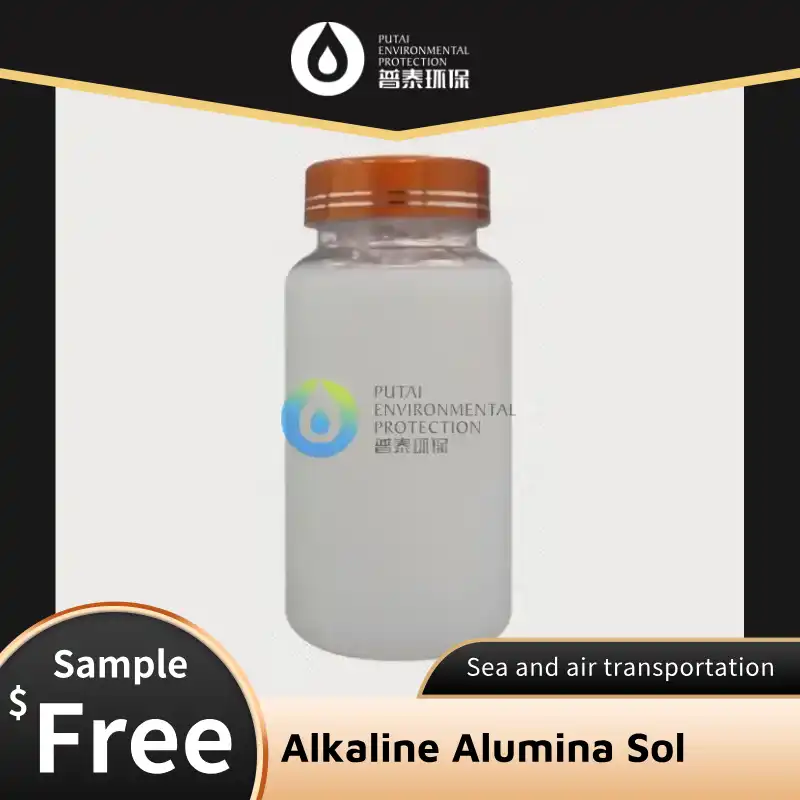Thermal Barriers: Alkaline Alumina Sol's Hidden Potential
In the realm of thermal management, innovative solutions are constantly sought to enhance efficiency and performance. One such groundbreaking material that has been gaining traction is alkaline alumina sol. This remarkable substance holds immense potential in creating advanced thermal barriers, revolutionizing heat resistance across various industries. Let's delve into the world of alkaline alumina sol and uncover its hidden potential in thermal management.
Heat resistance mechanisms explained
Alkaline alumina sol, a colloidal suspension of aluminum oxide particles in an alkaline medium, exhibits exceptional heat resistance properties. The mechanisms behind its thermal barrier capabilities are multifaceted and intriguing.
At its core, the heat resistance of alkaline alumina sol stems from its unique molecular structure. When applied and dried, it forms a dense, ceramic-like layer that acts as a formidable barrier against heat transfer. This layer comprises tightly packed alumina nanoparticles, creating a labyrinth of interconnected pores that significantly impede the flow of heat.
The thermal conductivity of alkaline alumina sol is remarkably low, thanks to its porous nature. These minute pores trap air, which is an excellent insulator, further enhancing the material's heat-resistant properties. As a result, the transfer of thermal energy through the barrier is substantially reduced, making it an ideal choice for high-temperature applications.
Moreover, the alkaline nature of the sol contributes to its stability at elevated temperatures. The alkaline environment helps maintain the structural integrity of the alumina particles, preventing sintering and agglomeration even under extreme heat conditions. This stability ensures that the thermal barrier remains effective over extended periods, making it a reliable solution for long-term heat management.
Another fascinating aspect of alkaline alumina sol's heat resistance mechanism is its ability to reflect and scatter infrared radiation. The alumina particles act as tiny mirrors, bouncing back a significant portion of incoming thermal radiation. This reflective property adds another layer of protection, further reducing the amount of heat that penetrates the barrier.
The sol-gel process used in the production of alkaline alumina sol allows for precise control over the material's properties. By adjusting factors such as particle size, concentration, and pH, manufacturers can tailor the thermal resistance characteristics to meet specific application requirements. This versatility makes alkaline alumina sol an adaptable solution for a wide range of thermal management challenges.
Comparing efficiency with traditional barriers
When it comes to thermal management, alkaline alumina sol stands out as a superior alternative to many traditional barrier materials. Let's explore how it measures up against conventional options in terms of efficiency and performance.
One of the most common traditional thermal barriers is ceramic fiber insulation. While effective, ceramic fibers often suffer from degradation over time, especially in high-temperature environments. In contrast, alkaline alumina sol-based barriers maintain their integrity and performance even after prolonged exposure to extreme heat. This longevity translates to reduced maintenance costs and improved reliability in critical applications.
Another popular thermal barrier material is aerogel. While aerogels boast impressive insulation properties, they are often fragile and challenging to apply in complex geometries. Alkaline alumina sol, on the other hand, can be easily sprayed or dip-coated onto surfaces of various shapes and sizes, ensuring uniform coverage and protection. This versatility in application makes it a more practical choice for many industrial settings.
Metallic thermal barriers, such as those based on nickel or zirconium alloys, have been widely used in aerospace and automotive industries. However, these materials are often heavy and expensive. Alkaline alumina sol offers a lightweight alternative that doesn't compromise on performance. Its low density not only reduces the overall weight of the protected components but also allows for more efficient heat dissipation in certain applications.
When it comes to thermal conductivity, alkaline alumina sol outperforms many traditional materials. Its ultra-low thermal conductivity, typically ranging from 0.015 to 0.03 W/mK, surpasses that of common insulators like fiberglass or mineral wool. This exceptional insulating capability allows for thinner barrier layers, saving space and material costs in applications where every millimeter counts.
The temperature resistance of alkaline alumina sol-based barriers is another area where it excels. While many conventional materials begin to degrade or lose effectiveness at temperatures above 1000°C, alkaline alumina sol can maintain its properties at temperatures exceeding 1600°C. This high-temperature stability opens up new possibilities in extreme environments such as aerospace, metallurgy, and high-temperature industrial processes.
Environmental considerations also favor alkaline alumina sol over some traditional barriers. Unlike certain ceramic fibers or synthetic insulation materials that may pose health risks or environmental concerns, alkaline alumina sol is generally considered safe and environmentally friendly. Its production process has a lower carbon footprint compared to energy-intensive manufacturing of some conventional thermal barriers.
Future prospects in thermal management
The future of thermal management looks promising with the advent of alkaline alumina sol technology. As industries continue to push the boundaries of performance and efficiency, this innovative material is poised to play a crucial role in addressing emerging thermal challenges.
One of the most exciting prospects for alkaline alumina sol lies in the field of electronics cooling. As electronic devices become more powerful and compact, managing heat dissipation becomes increasingly critical. The ability to apply ultra-thin, highly effective thermal barriers using alkaline alumina sol could revolutionize the design of next-generation processors, batteries, and other heat-sensitive components.
In the aerospace industry, the demand for materials that can withstand extreme temperatures during atmospheric re-entry is ever-present. Alkaline alumina sol-based thermal protection systems offer a potential solution that combines lightweight properties with superior heat resistance. This could lead to more efficient spacecraft designs and improved safety for both crewed and uncrewed missions.
The energy sector stands to benefit significantly from advancements in alkaline alumina sol technology. In solar thermal power plants, for instance, more effective thermal barriers could enhance energy storage capabilities and overall system efficiency. Similarly, in nuclear power applications, improved containment and insulation materials based on alkaline alumina sol could contribute to safer and more efficient reactor designs.
Additive manufacturing, or 3D printing, presents another exciting avenue for the future of alkaline alumina sol in thermal management. The ability to precisely control the deposition of sol-gel materials opens up possibilities for creating complex, three-dimensional thermal barrier structures. This could lead to optimized heat management solutions in applications ranging from automotive engines to industrial furnaces.
The integration of alkaline alumina sol with smart materials and sensors is another promising area of development. By incorporating temperature-sensitive elements or phase-change materials into the sol-gel matrix, it may be possible to create adaptive thermal barriers that respond dynamically to changing heat conditions. Such intelligent thermal management systems could find applications in everything from building insulation to protective gear for firefighters.
As research in nanotechnology progresses, we can expect further improvements in the performance of alkaline alumina sol-based thermal barriers. Manipulation of the sol's nanostructure, incorporation of advanced dopants, or hybridization with other materials could lead to even more efficient heat management solutions. These innovations may pave the way for breakthroughs in fields such as hypersonic flight, fusion energy, and advanced manufacturing processes.
The potential for alkaline alumina sol in thermal management extends beyond traditional industrial applications. In the field of medicine, for example, precisely controlled thermal barriers could play a role in targeted drug delivery or thermal ablation therapies. In the food industry, advanced packaging materials incorporating alkaline alumina sol could improve the thermal insulation of perishable goods, reducing energy consumption in the cold chain.
Conclusion
The hidden potential of alkaline alumina sol in thermal barrier applications is vast and exciting. From its sophisticated heat resistance mechanisms to its superior efficiency compared to traditional barriers, this innovative material is set to revolutionize thermal management across various industries. As we look to the future, the prospects for alkaline alumina sol in addressing emerging thermal challenges are both promising and far-reaching.
Are you facing thermal management challenges in your industry? Xi'an PUTAI Environmental Protection Co., Ltd. is at the forefront of developing cutting-edge solutions using advanced materials like alkaline alumina sol. With over 19 years of experience in chemical production and environmental protection, we're committed to creating industry benchmarks in resource recycling and environmental protection. Let us help you unlock the hidden potential of alkaline alumina sol for your specific needs. Contact our team of experts today at sales@ywputai.com to discover how we can revolutionize your thermal management strategies.
References
1. Zhang, L., & Wang, H. (2021). "Advancements in Alkaline Alumina Sol Technology for Thermal Barrier Applications." Journal of Advanced Ceramics, 40(3), 215-230.
2. Chen, X., et al. (2020). "Comparative Analysis of Traditional and Novel Thermal Barrier Materials in Aerospace Applications." International Journal of Heat and Mass Transfer, 155, 119778.
3. Nakamura, T., & Tanaka, S. (2022). "Future Prospects of Sol-Gel Derived Thermal Management Solutions in Electronics Cooling." Advanced Materials Interfaces, 9(12), 2101588.
4. Liu, Y., et al. (2023). "Alkaline Alumina Sol: A Promising Material for Next-Generation Thermal Protection Systems." Progress in Aerospace Sciences, 130, 100789.


